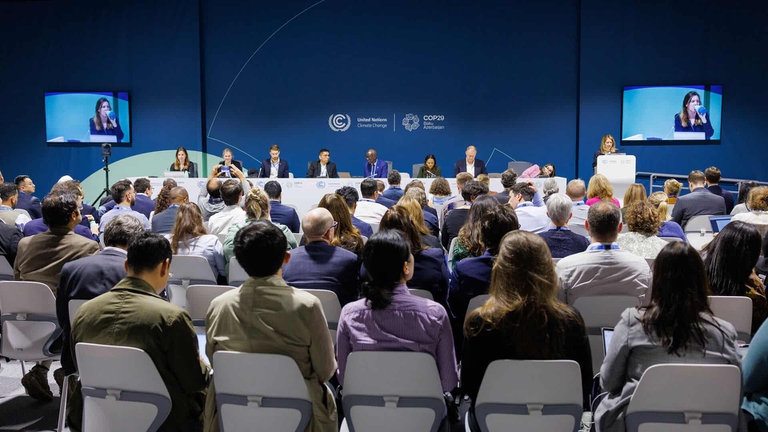https://www.lifegate.it/finanza-climatica-cop29
- |
The negotiations at Cop29 in Baku they are all focused on a crucial theme: find the funds necessary to operate the tecological transition, mitigate climate change and adapt to the now inevitable impacts that they entail.It is therefore necessary to decide how much capital allocate and, above all, understand who should be doing it.
The draft drawn up in June was rejected by the G77+China at Cop29
The news coming from Baku, in this sense, are not at all reassuring.The distance between governments (or groups of governments) is so wide that as far as what has been baptized is concerned the UAE dialogue – the comparison necessary to make it operational as indicated in the Global stocktake approved at the end of Cop28 in Dubai – we basically don't agree on anything.Not even on what topics should be addressed in this dialogue, with what objectives and for what duration.In practice, since Monday we have been discussing what it is the UAE dialogue.
It is no coincidence that, although we have now reached Thursday of the first week of negotiations, a first draft on the topic has not yet been published: only some informal notes.This is also because the draft that had been edited by Egypt And Australia, and dismissed at the end of the intermediate session in June, in Bonn, was rejected by the G77+China group, as it is considered a compromise between the North and South of the world that is too unbalanced in favor of the rich.
Objective:well exceed the 100 billion dollars per year established at COP15
To understand what we are talking about, however, it is useful to take a step back a few years.At the Cop15 in Copenhagen, in 2009, governments agreed on a principle:transfer 100 billion dollars a year from rich to poorer countries to enable the latter to help mitigate the climate changes and adapt to their impacts.This is because many vulnerable nations suffer serious consequences, despite being only minimally responsible for them greenhouse gas emissions.
That figure was only reached in 2022.In the meantime, however, the needs have increased enormously.Thus, it was decided to create a new mechanism for climate financing, which takes the name of New collective quantified goal on climate finance (Ncqg).It should make it possible to well exceed the 100 billion dollar mark.However, it has never been precisely indicated what the new objective is:at COP29 in Baku, among other issues, precisely this is being discussed.
How much money is needed to support developing economies
At the Cop27 in Sharm el-Sheikh one was asked Group of high-level experts to estimate the needs of developing and emerging countries starting from 2030.The figure of was indicated 2,400 billion dollars a year, which however also includes allocations for the bottom loss and damage, or to deal with the necessary repairs for losses and damages suffered.
Problem:at Cop29 the figures talked about are decidedly far from what the experts indicated.A target set at one trillion a year.Then a proposal arrived from the developing countries themselves indicated the figure of 1,300 billion dollars.In any case, we are talking about an objective:it will then be necessary to verify how much will actually be allocated.
Who must contribute by allocating the necessary capital
And at the same time it will be necessary to address the question of who will be called upon to allocate the funds.In fact, there are nations that are speculating a very different approach compared to that of COP15:in fact, rich countries ask that developing nations themselves can also contribute.Which the latter tend, as can easily be imagined, to exclude.

To complicate everything, then, there is the question of China, which is still considered byUnfccc – the United Nations Framework Convention on Climate Change – as, indeed, a developing country.The Asian nation, however, has recorded a trend in recent decades exponential economic growth.Finally, there is a third option that emerged in the informal note, which constitutes a compromise between the first two.
It will require 6,300-6,700 billion dollars per year globally
While negotiations are in full swing, another estimate has arrived on the amount which will have to reach the climate finance, which does not only take into account developing economies.In fact, the Group of high-level independent experts (supported by the Brokings Institution and the London School of Economics) presented a new document at COP29 in which it indicates the investment needs expected at global level in "approximately 6,300-6,700 billion dollars per year by 2030 overall, of which 2,700-2,800 billion in advanced economies, 1,300-1,400 billion in China, and 2,300-2,500 billion in other developing countries”.
The analysis also explains that we need to focus on grants and not on loans.This is to avoid weighing on the already fragile economies that will benefit from the funds, so that they are not found crushed by debt contracts.The pressure of the group of the Poorer countries of the world, who ask that at least 220 billion per year be insured for them (while the small ones Island states, gathered in the Aosis group, propose that they receive at least 39).In short, there is a lot of work to be done to prevent COP29 from ending in stalemate.
